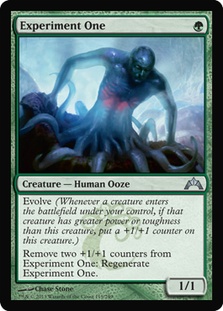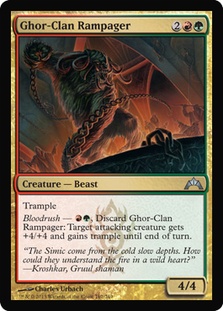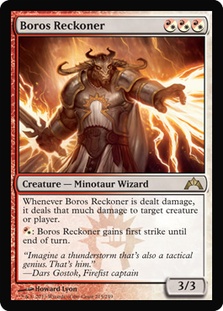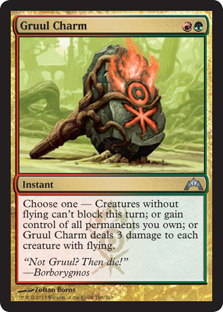One of the ways to evaluate new cards is to compare them to what came before; it wasn’t hard to find comparisons for Experiment One. Only sixteen of 146 green one-drops can break the one-power barrier without additional mana investment, and only Dryad Militant, Wild Nacatl, Nimble Mongoose, Tattermunge Maniac, and Nettle Sentinel avoid unmanageable drawbacks. Combined, these guys have a pretty fine tournament resume. Experiment One definitely felt like it fit in with this class of beaters. I just had to find him a home.
Naya seemed to be the frontrunner at first, but I quickly dismissed it because the deck’s preferred creatures do not have a progressive enough curve to grow EX1 into a Wild Nacatl. It has too many white 2/2 or 2/1 creatures for a smooth natural evolve chain. Naya is a deck that really wants to have its mana dork, and EX1 and most mana dorks don’t really get along too well. If the old standby Zoo colors are not a home for this card, maybe we should just shave the white.
R/G seemed to hold some promise with a very natural curve to grow a 3/3 Experiment. Strangleroot Geist is an Ooze’s best friend. Flinthoof Boar is a flexible two-drop that is also a fine follow up on turn 3 with haste. Hellrider and Thundermaw feel like a natural end to this aggressive curve. When Ghor-Clan Rampager was spoiled, it instantly went in the deck as a three-of since it helps solve the Loxodon Smiter / Restoration Angel problem. Boros Reckoner is an insane card and was the final nail in the coffin for the Gruul Experiment. Red-based removal was just not going to be good enough to handle the 4/4 Smiter, 3/4 Angel, and 3/3 Reckoner.
Dreadbore and Abrupt Decay felt like exactly where the deck needed to be when dealing with Smiter and Reckoner. Moving into Jund also added the possibilities of three creatures in Deathrite Shaman, Dreg Mangler, and Falkenrath Aristocrat. Good, ever-flexible Jund. Why shop anywhere else? With a proper home found, building and tweaking went into high gear. The deck felt and played extremely solid. SCG Standard Open: Atlanta could not arrive soon enough. Every evening was full of apprehension, waiting for some writer to write an article on the Experiment in Jund. Smi77y came pretty close before moving on to another brew. Everyone else seemed content to remain in Gruul or Naya.
The quest to find a home for Experiment One resulted in one of the most aggressive decks in the new format. A few guys were convinced to put the Experiment to the test at SCG Standard Open: Atlanta, including a devout Esperian by the name of Tyler Lindsey, who was able to pilot the list to a 4th place finish. This is the list that was registered. (A huge shout out goes to Cedric Phillips, who took time out of his travel schedule to send a nearly article-length reply to a question from a stranger. Lots of his advice confirmed our thoughts and influenced our final sideboard.)
Creatures (28)
- 4 Strangleroot Geist
- 4 Hellrider
- 2 Thundermaw Hellkite
- 3 Flinthoof Boar
- 4 Dreg Mangler
- 3 Deathrite Shaman
- 4 Experiment One
- 4 Ghor-Clan Rampager
Lands (24)
Spells (8)

The goldfish turn of this deck is absurd. EX1 into Geist attacks for four; opponent is down to sixteen. Dreg Mangler / Flinthoof Boar attack for eight; opponent is at eight. Even if they Verdict here, you are left with five power of attackers on the board. (Regenerate EX1, undying Geist triggers evolve, leaving you with a 3/2 and a 2/2). With eighteen other cards pre-board that deal three damage, your opponent is in a pretty bad position.
All good aggressive strategies start with a one-drop. Many suggested Dryad Militant, but Militant is just too fragile and dies to everything. Deathrite Shaman evolves EX1, is virtually immune to Azorius Charm, hedges vs. Reanimator strategies, and really forces the U/W/R decks to make some hard choices about what needs to die. In a deck that is forced to aggressively use twelve shocklands, the life gain it provides is also a much-needed buffer versus the format’s red decks. The deck began with a 4/3 split of EX1 / Deathrite Shaman. It never felt wrong and stayed that way throughout.
Two mana gets a whole lot of value in this deck. Strangleroot Geist is a resilient beater. Flinthoof Boar is quite the steal if you have a Mountain and can function at three, adding flexibility to play sequencing. Searing Spear is the industry standard removal at the moment. Making the leap to running the full four Abrupt Decay was most likely the biggest breakthrough for the deck. Decay is the least painful way to deal with Reckoner and Smiter. It also acts as a Naturalize against Bant Hexproof, deals with Volcanic Strength from the red decks, and is an answer to Blind Obedience (although Obedience is more of an annoyance than a real beating.)
The true star of the deck, however, is Rampager at two. The first time you bloodrush a creature, the game changes. As long as there is open mana, there are no good blocks. Cards that allow the opponent to be punished for making the correct play are absolutely insane. When it is no longer safe for a control deck to use Augur of Bolas to block a 1/1 Experiment One is when you know a card is amazing.
Dreg Mangler at three was the choice creature in order to be as aggressive as possible. Mangler continues the EX1 evolve chain while being a creature that lends a hand even after it has died. This leads nicely into Hellrider and Thundermaw Hellkite as curve toppers. There is also no shame at all in just hard casting Ghor-Clan Rampager. This might be the first creature printed without an ETB trigger that is just miserable to Unsummon or Azorius Charm.
The last maindeck choice was a tough call. Do we run two Pillar of Flame or two Tragic Slip? Pillar is fine and has plenty of targets in the format. The deck is full of 3/3 or better creatures and quickly outclasses the prime Pillar targets. Slip was the choice for the ability to interact with Restoration Angel in the red zone. The ability to Tragic Slip an Angel blocking a 3/3 was exactly what the deck wanted.
The sideboard is pretty straightforward. Temblor is good versus the Naya Humans deck that is a slightly bad matchup for us. Gruul Charm is there because sometimes all you need is one more attack. The main reason for its inclusion was to break the board stalls that happen in the green creature matchups. It does not take long for a few 3/3s and a couple of Hellriders to go lethal if the opponent cannot block. Also relevant is the three damage to all flyers ability. Vampire Nighthawk, Olivia Voldaren, Drogskol Captain, and his Spirit buddies all can be Charmed away.
All three modes of Golgari Charm are relevant in this deck. The -1/-1 can even be used to remove some opposing creatures while growing EX1 to a 4/4. Tribute to Hunger might seem out of place, but it was the best solution we could come up with for Geist of Saint Traft and his endless wardrobe of enchantments.
Going forward the deck should replace the Thundermaw Hellkites with Falkenrath Aristocrats. Thundermaw underperformed all tournament long and in most cases was just too slow. The matchups with the midrange decks need to be improved as they are currently the hardest ones for the deck. The good matchups are U/W/R decks and the red aggro decks. The number of identical threats can overwhelm U/W/R decks’ limited removal suites, and the deck’s creatures quickly outclass the 2/x creatures of the red aggro decks. It will be interesting to see the evolution of this as the format matures.
This is the list I recommend going forward:
Creatures (28)
- 4 Strangleroot Geist
- 3 Falkenrath Aristocrat
- 3 Hellrider
- 3 Flinthoof Boar
- 4 Dreg Mangler
- 3 Deathrite Shaman
- 4 Experiment One
- 4 Ghor-Clan Rampager
Lands (24)
Spells (8)

A special thanks and shout out to the guys who helped and played with the deck. (Ethan, Malone, Theo, Josh, Andrew, and most importantly Tyler.)
JW Kingsley




